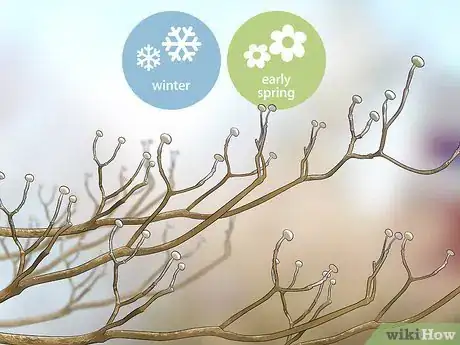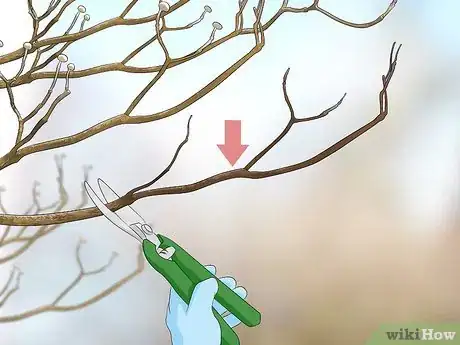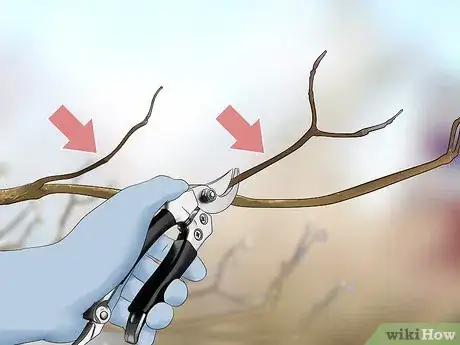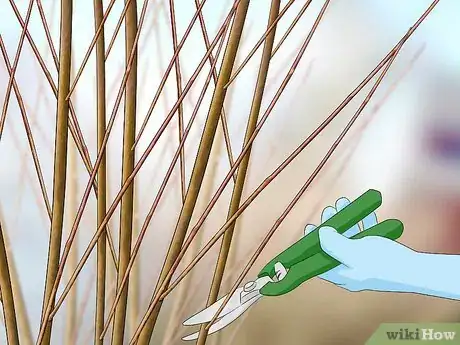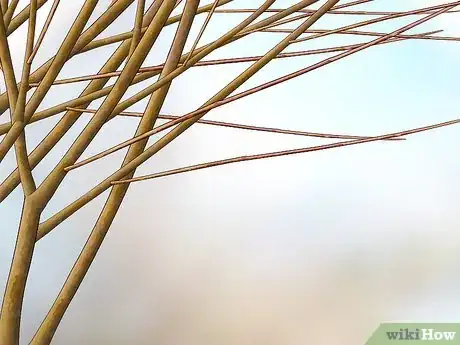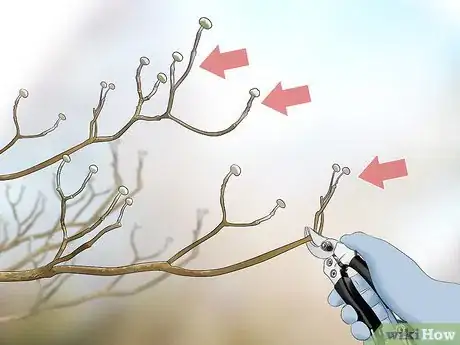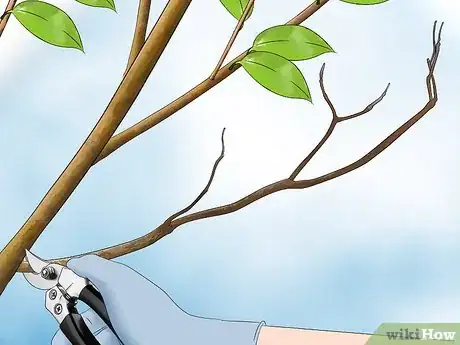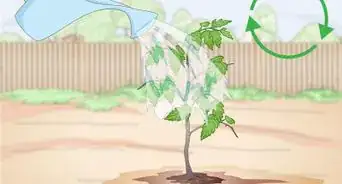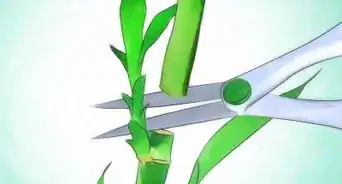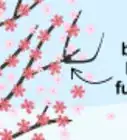This article was co-authored by Steve Masley and by wikiHow staff writer, Jessica Gibson. Steve Masley has been designing and maintaining organic vegetable gardens in the San Francisco Bay Area for over 30 years. He is an Organic Gardening Consultant and Founder of Grow-It-Organically, a website that teaches clients and students the ins and outs of organic vegetable gardening. In 2007 and 2008, Steve taught the Local Sustainable Agriculture Field Practicum at Stanford University.
wikiHow marks an article as reader-approved once it receives enough positive feedback. This article received 12 testimonials and 90% of readers who voted found it helpful, earning it our reader-approved status.
This article has been viewed 247,594 times.
Dogwood trees do not usually need much pruning. Even without manually shaping the tree, a dogwood will usually maintain a nice shape. Manual shaping can be done if desired, though. Do your primary pruning—the removal of branches—during the dormant season and your secondary pruning—cutting done to spur new growth—during the active growing season.
Steps
Primary Pruning
-
1Remove branches during the winter or early spring. The dogwood should still be in a dormant state when you remove branches. Sawing or otherwise removing branches during the late spring or summer, after the tree begins to actively grow, can create fresh, appealing entry spots for insects that like to bore into the wood of the tree.[1]
-
2Remove deadwood. Wood that is dying or dead will do nothing good for your tree. In fact, leaving it on the tree may actually cause problems. Deadwood is more likely to grow mold or other fungi, which can then spread to healthy parts of the dogwood.[2]Advertisement
-
3Cut off diseased or insect-infested branches. Like dead branches, diseased branches will only invite further infection to the rest of your dogwood. When cutting off noticeably diseased branches, you should dip the shears or saw into a solution made of one part bleach and three parts water to sterilize them. Otherwise, you may accidentally spread the disease to other parts of the tree.[3]
-
4Prune away old, twiggy stems. Some dogwood varieties, particularly the shrubby types, are valued mostly for the colorful bark that grows on new stems. You can either cut back the old stems on these dogwoods or cut them down completely. For shrubby dogwoods, you can actually cut the dogwood down to the ground every few years to remove old stems and encourage the growth of new twigs.[4]
-
5
-
6Remove shoots that grow below the graft point. Some hybrid or variegated dogwood varieties are created by grafting together two separate dogwood trees. A branch that grows beneath the grafting point will have characteristics of one of the original trees used for the hybrid, rather than the hybrid dogwood itself. To keep the foliage and appearance of the tree consistent, you should remove these unexpected branches by sawing or pruning them off at the point of origin.[7]
-
7Determine whether or not you need to remove lower branches. Sometimes, the lowest branches of the dogwood can interfere with walking or other gardening activities. Other times, the branches hang so low that the underside of the tree does not receive enough air. In either case, the lowest branches can be sawed off or cut away with heavy-duty shears.
Secondary Pruning
-
1Snip away the flower buds. Cut off the buds at the tip of each branch to redirect energy to buds on the side of the branch. By removing a singe bud, you encourage the development of multiple buds, leading to a fuller setting of flowers. These buds can either be snipped off with shears or pinched off by hand.
-
2Prune your dogwood to encourage flowering in early summer. June is generally considered the best month for this type of pruning, but any time in the early summer will work. You should not snip buds off during the dormant season since doing so will cut the flowers off before they have the chance to open, rather than simply redirecting the energy. Do not wait too late into the summer, though, because doing so will not allow the buds to build up enough energy for new shoots and buds for the next year.[8]
Community Q&A
-
QuestionHow do I prune a dogwood tree that has grown to 18 feet tall and has very few branches that spread out?
 Community AnswerIf you are attempting to create a fuller canopy, you can prune the main leader branch back to encourage more growth in the lower, more horizontal branches. Pruning with ladders can be very dangerous, so a polesaw is recommended. If it is too tall to be reached comfortably or safely, an arborist can be hired to do the work for you.
Community AnswerIf you are attempting to create a fuller canopy, you can prune the main leader branch back to encourage more growth in the lower, more horizontal branches. Pruning with ladders can be very dangerous, so a polesaw is recommended. If it is too tall to be reached comfortably or safely, an arborist can be hired to do the work for you. -
QuestionCan I trim back the height in September?
 Community AnswerYes, dogwoods are fairly tough and can handle more intensive pruning than some other common garden shrubs.
Community AnswerYes, dogwoods are fairly tough and can handle more intensive pruning than some other common garden shrubs. -
QuestionWhat is a kousa dogwood tree?
 Community AnswerA kousa is a variety of dogwood that can grow in a higher ground moisture content and shaded areas. You may find it to be very slow growing and have a shorter ultimate height.
Community AnswerA kousa is a variety of dogwood that can grow in a higher ground moisture content and shaded areas. You may find it to be very slow growing and have a shorter ultimate height.
Things You’ll Need
- Heavy shears
- Handsaw
References
- ↑ https://www.rhs.org.uk/advice/profile?pid=161
- ↑ https://www.extension.purdue.edu/extmedia/HO/HO-4-W.pdf
- ↑ https://www.extension.purdue.edu/extmedia/HO/HO-4-W.pdf
- ↑ https://www.chicagobotanic.org/plantinfo/gardening_tips_and_techniques/winter_pruning
- ↑ https://www.chicagobotanic.org/plantinfo/gardening_tips_and_techniques/winter_pruning
- ↑ Steve Masley. Home & Garden Specialist. Expert Interview. 20 March 2019.
- ↑ https://content.ces.ncsu.edu/grafting-and-budding-nursery-crop-plants
- ↑ http://agproducts.rutgers.edu/dogwood/growing-tips.html
About This Article
To prune a dogwood tree, work during winter or early spring, since the tree should still be in a dormant state when you remove branches. Using gardening shears, cut off any dead or diseased branches you notice, which will prevent the infection from spreading to the rest of the tree. Additionally, make sure to sterilize your shears in a solution of 1 part bleach and 3 parts water between snips so you don’t accidentally spread the disease as you’re pruning! Besides diseased branches, thin out crowded areas and cut off old, twiggy stems. To learn how to do secondary pruning, read on!
